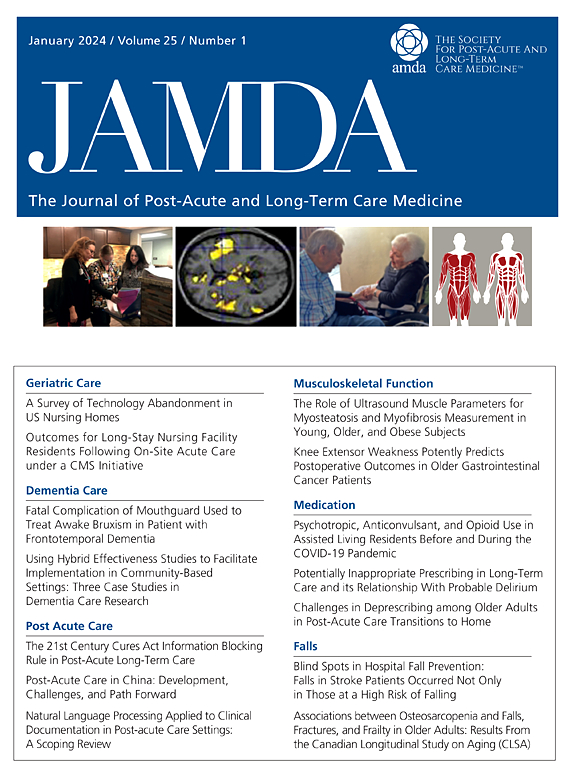长期护理需求评估:从框架到实践。
IF 4.2
2区 医学
Q2 GERIATRICS & GERONTOLOGY
Journal of the American Medical Directors Association
Pub Date : 2025-02-01
DOI:10.1016/j.jamda.2024.105409
引用次数: 0
摘要
目标:确定并描述各国用于进行功能能力评估的工具,作为其长期护理系统的资格条件,并将其与世界卫生组织提出的现有健康老龄化框架(内在能力和功能)进行比较:设计:描述性案例研究:环境和参与者:27 个国家的国家级长期护理系统:方法:选择已建立长期护理系统且预计长期护理需求会增加的国家。收集每个国家的国家特征数据、长期护理系统信息以及评估长期护理需求(功能能力)的工具。将评估工具的特点与世界卫生组织的内在能力和功能领域进行了比较,确定了评估的具体活动以及用于对人员进行分类和确定福利的评估方式:结果:我们将各国划分为拥有长期护理系统和用于评估长期护理需求的标准化工具的国家(第 1 组;n = 6)、拥有长期护理措施但没有标准化工具来确定需求的国家(第 2 组;n = 8)以及没有关于其系统或确定长期护理需求的工具的信息的国家(第 3 组;n = 13)。在拥有标准化工具的国家中,工具包括与认知、行动能力和心理能力等内在能力领域相关的几项活动;在功能能力方面,工具涵盖了除 "贡献 "能力之外的所有领域:长期护理需求评估是长期护理系统必须执行的一项复杂而又必要的任务。开始设计和重新设计其系统的国家可以利用现有的工具、框架和其他国家的经验,使这一过程更好地适应本国的需求和环境。本文章由计算机程序翻译,如有差异,请以英文原文为准。
Long-Term Care Needs Assessment: From Frameworks to Practice
Objectives
Identify and describe instruments used by countries to perform functional ability assessment as eligibility for their long-term care systems and compare them to existing healthy aging frameworks proposed by the World Health Organization (intrinsic capacity and functionality).
Design
Descriptive, case studies.
Setting and Participants
Country-level long-term care systems in 27 countries.
Methods
Selection of countries with long-term care systems in place and with expected increase in long-term care needs. For each country, data regarding the country features, as well as information of the long-term care systems, and the instruments to assess long-term care needs (functional ability) were collected. Features of the assessment tools were compared with the World Health Organization's intrinsic capacity and functionality domains, identifying the specific activities evaluated and the way the assessment is used to classify people and define benefits.
Results
Countries were classified into those with a long-term care system and a standardized instrument for assessing long-term care needs (group 1; n = 6), those that have long-term care initiatives do not have a standardized instrument to identify needs (group 2; n = 8), and those with no information on their systems or instruments for identify long-term care needs (group 3; n = 13). When looking at countries with standardized tools, instruments include several activities related to intrinsic capacity domains such as cognition, mobility, and psychological capacity; for functional ability, all domains except the ability to “contribute” are covered by the instruments.
Conclusions and Implications
Long-term care needs assessment is a complex but necessary task to be performed by long-term care systems. Countries embarking in the design and redesign of their systems can use the existing instruments, frameworks, and the experience from other countries to better adapt this process to their own needs and contexts.
求助全文
通过发布文献求助,成功后即可免费获取论文全文。
去求助
来源期刊
CiteScore
11.10
自引率
6.60%
发文量
472
审稿时长
44 days
期刊介绍:
JAMDA, the official journal of AMDA - The Society for Post-Acute and Long-Term Care Medicine, is a leading peer-reviewed publication that offers practical information and research geared towards healthcare professionals in the post-acute and long-term care fields. It is also a valuable resource for policy-makers, organizational leaders, educators, and advocates.
The journal provides essential information for various healthcare professionals such as medical directors, attending physicians, nurses, consultant pharmacists, geriatric psychiatrists, nurse practitioners, physician assistants, physical and occupational therapists, social workers, and others involved in providing, overseeing, and promoting quality

 求助内容:
求助内容: 应助结果提醒方式:
应助结果提醒方式:


